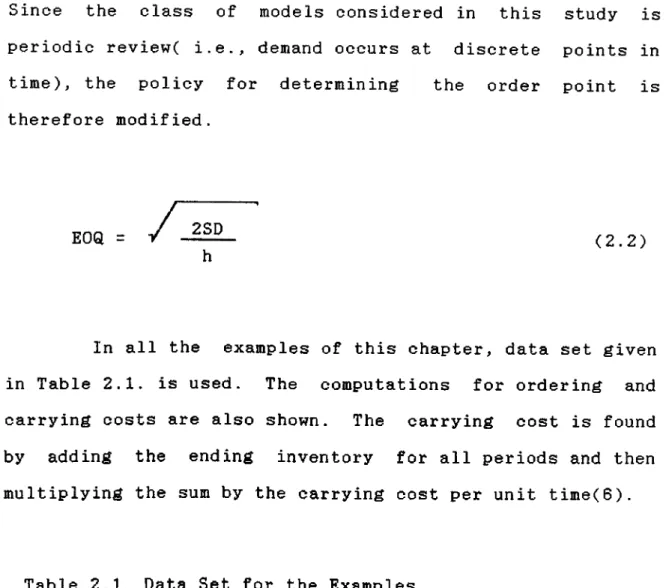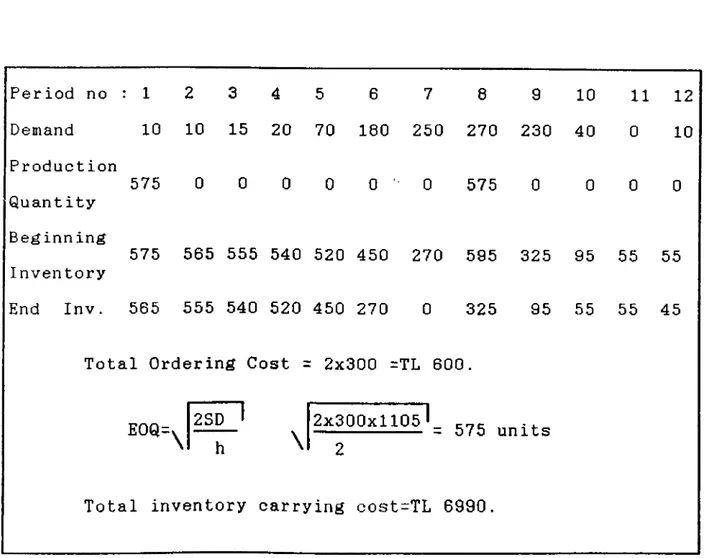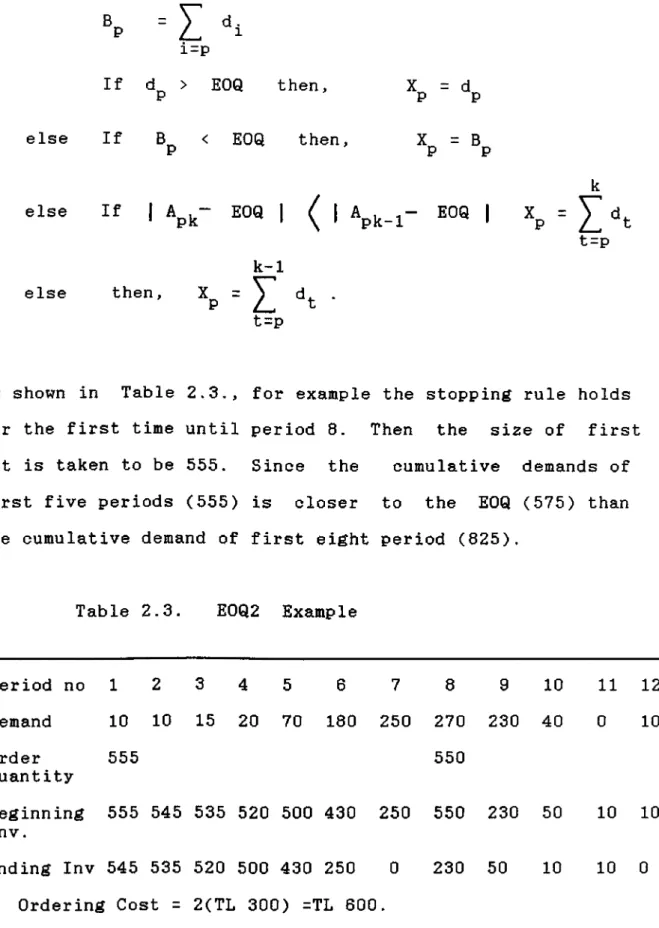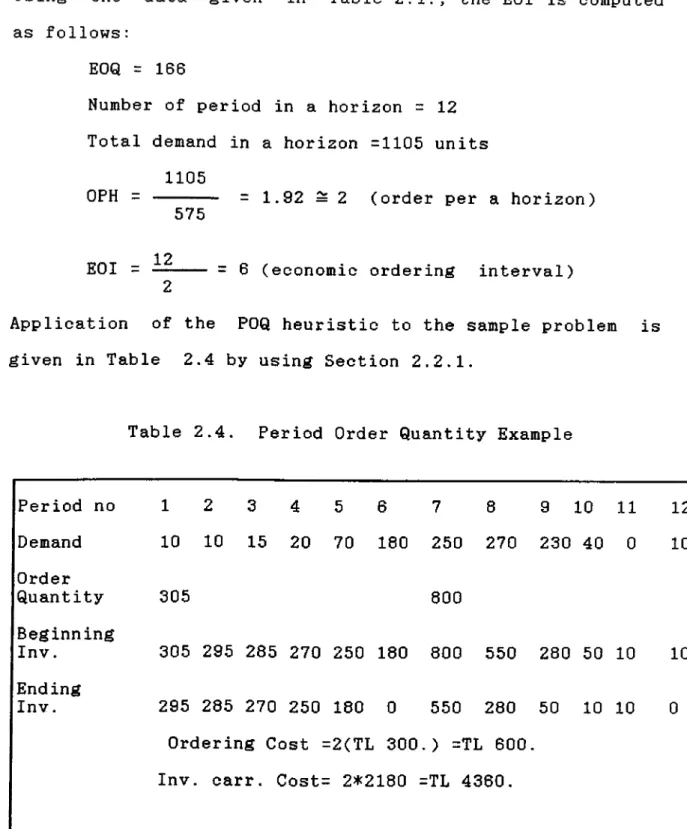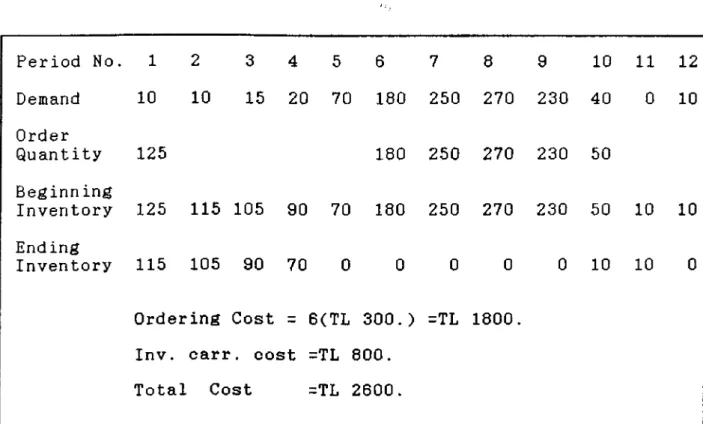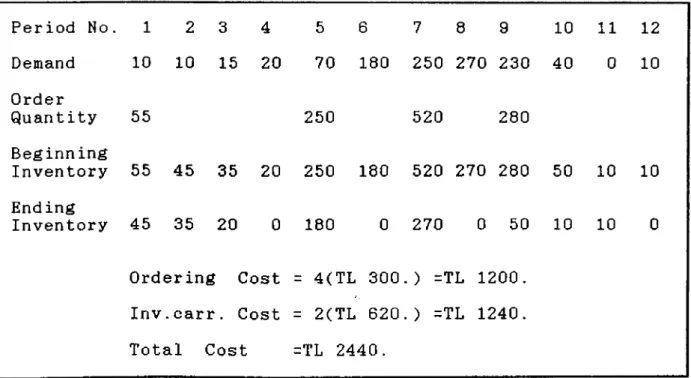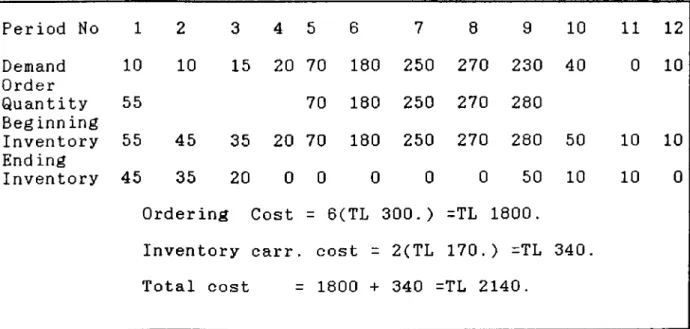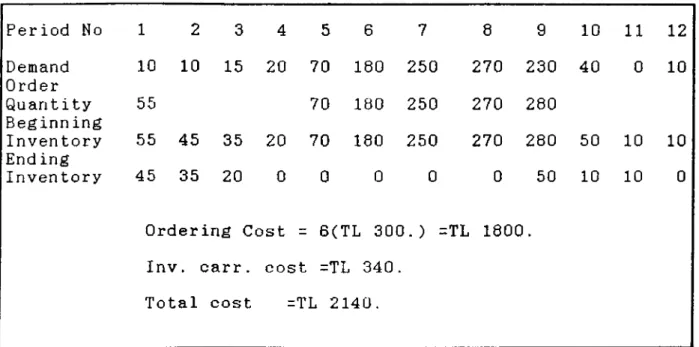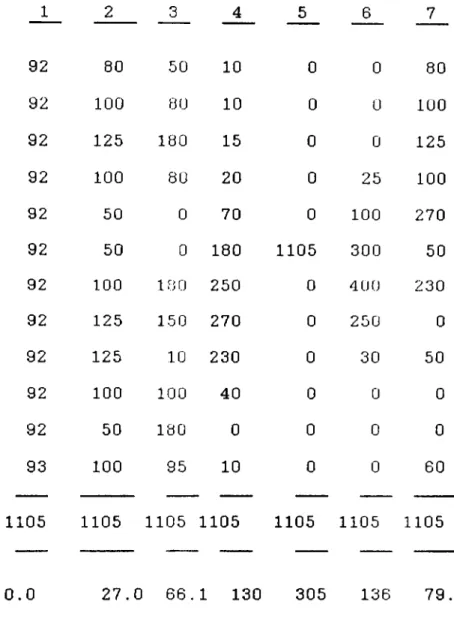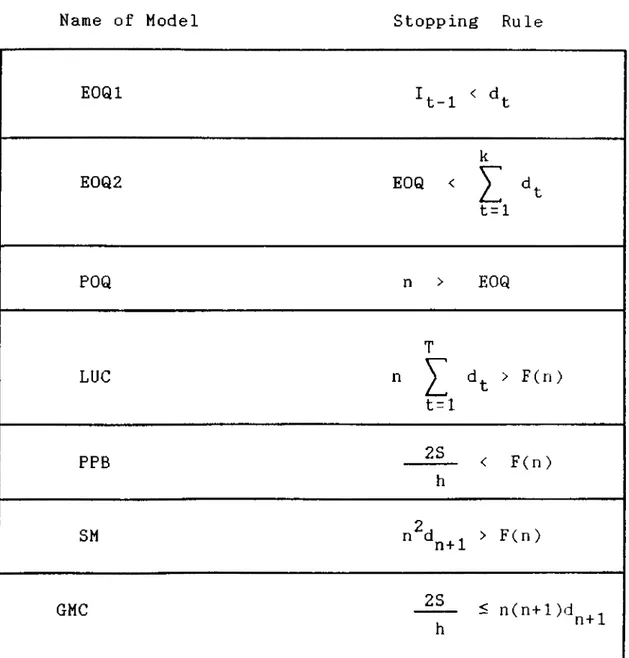.'■ Ѵи .U i'.·'· " .''. ■-.V*.'·. * -ÿ*'. jíV·.* ■ :^'ч»*." ^?^.·βί^“ί.··^ J·-*.- *;' ' V
*Ниг '«й/ — ■ Í V - S í - ' W ^ . i . « U ./..■¿•»i‘í
*·■,V -··. ■· ; .. V .- ; ;'' ¿ , •;r*rf*·· 'Ίί«·· · •,·^·' “ϊ·*
HEURISTIC SOLUTION MODELS FOR THE SINGLE ITEM, UNCAPACITATED
LOT-SIZING PROBLEMS
A THESIS
SUBMITTED TO THE DEPARTMENT OF MANAGEMENT AND THE GRADUATE SCHOOL OF BUSINESS ADMINISTRATION
OF BILKENT UNIVERSITY
IN PARTIAL FULFILLMENT OF THE REQUIREMENTS FOR THE DEGREE OF
MASTER OF BUSINESS ADMINISTRATION
By
DEMET ÇAPAN January, 1990
I certify that I have read this thesis and that in my opinion it is fully adequate, in scope and in quality, as a thesis for the degree of Master of Business Administration.
Assist. Prof. Erdal Erel
I certify that I have read this thesis and that in my
opinion it is fully adequate, in scope and in quality, as a thesis for the degree of Master of Business Administration.
I certify that I have read this thesis and that in my
opinion it is fully adequate, in scope and in quality, as a thesis for the degree of Master of Business Administration.
Assist. Prof. Kür?at Aydogan
Approved for the Graduate School of Business Administration
ACKNOWLEDGEMENT
I wish to thank Dr.Erdal Erel, Dr.Kur?at Aydog^an
and Dr. Dilek Yeldan for their advice, guidance, and
ABSTRACT
HEURISTIC SOLUTION MODELS FOR THE SINGLE ITEM, UNCAPACITATED
LOT-SIZING PROBLEMS
Demet Çapan M.B.A. In Management
Supervisor ; Assist. Prof. Erdal Erel
January 1990, 79 pages
Single item, deterministic, periodic review,
uncapacitated production/inventory models are especially
important because of their applications in material
requirements planning (MRP) systems. In this thesis, the
relevant literature is reviewed and the performance of
EOQl, E0Q2, POQ, LUC, PPB, SM and GMC heuristic models are
ÖZET
ENVANTER BÜYÜKLÜĞÜ TESBIT PROBLEMLERİNDE KULLANILABİLECEK TEK ÜRÜNLÜ, SINIRSIZ, SEZGİSEL ÇÖZÜM YÖNTEMLERİ
Demet Çapan
İŞ idaresi Yüksek Lisans
Tez Yönetmeni : Yrd. Doç. Dr. Erdal Erel
Ocak 1990, 79 sayfa.
Tek ürünlü, deterministik, periodik inceleme ve sı
nırsız ürün/envanter modelleri malzeme ihtiyaç planlaması
sistemlerinde yaygın uygulama alanına sahip olmaları açı
sından, özellikle önemlidirler. Bu tez çalışmasında, konu
ya ilişkin literatür özetle gözden geçirilmiş, E0Q1, E0Q2,
P0Q, LUC, PPB, SM and GMC isimli sezgisel yöntemlerin
PAGE
ABSTRACT... iv
ÖZET... V LIST OF TABLES... viii
LIST OF FIGURES... ix
CHAPTERS I. 1 .1 . INTRODUCTION... 1
1 .2. CLASSIFICATION OF PRODUCTION/INVENTORY MODELS. . . 1
1.3. MODEL CONSTRUCTION... 2
1.3.1. THE ASSUMPTIONS OF THE MODEL... 3
1.3.2. IMPLICATIONS OF THE ASSUMPTIONS... 5
1.4. PURPOSE OF THE THESIS... 6
1.5. THESIS OUTLINE... 6
II. HEURISTIC SOLUTION MODELS... 7
2.1. ECONOMIC ORDER QUANTITY MODEL... 9
2.1.1. ECONOMIC ORDER QUANTITY 1 MODEL... 11
2.1 .1 .1 . EOQl PROCEDURE... 13
2.1.2. ECONOMIC ORDER QUANTITY 2 MODEL... 14
2.1.2.1. EOQ2 PROCEDURE... 16
2.2. PERIODIC ORDER QUANTITY MODEL... 17
2.2.1. POQ PROCEDURE... 19
2.3. LEAST UNIT COST MODEL... 20
2.3.1. LUC PROCEDURE... 23
2.4. PART PERIOD BALANCING MODEL... 24
2.4.1. PPB PROCEDURE... 28
2.5. SILVER AND MEAL HEURISTIC MODEL... 29
2.6. GROFF MARGINAL COST MODEL... 33
2.6.1. GMC PROCEDURE... 36
III. COMPUTATIONAL DATA SETS FOR COMPARISON OF THE HEURISTIC MODELS... 37
3.1. THE RESULT OF EXPERIMENTATION... 38
3.2. DISCUSSION OF HEURISTIC MODELS WITH RESPECT TO THEIR PROCEDURES... . 3.3. ANALYSIS OF RESULTS... 42
IV. CONCLUSIONS... 45
REFERENCES...48
APPENDIX A. (TABLES)...50
APPENDIX B (LISTING OF THE COMPUTER)... 66
VARIABLES DESCRIPTION ... 67
PROCEDURES DESCRIPTION ... 68
LIST OF TABLES
TABLE NO PAGE NO
2.1 DATA SET FOR THE EXAMPLE... 10
2.2 EOQl EXAMPLE...12
2.3 E0Q2 EXAMPLE...15
2.4 PERIOD ORDER QUANTITY EXAMPLE... 18
2.5 LEAST UNIT COST EXAMPLE... 22
2.6 PART PERIOD BALANCING EXAMPLE... 27
2.7 SILVER AND MEAL EXAMPLE... 31
2 . 8 GROFF MARGINAL COST EXAMPLE... 35
3.1 DEMAND DATA SETS... 51
3.2 COST DATA...52
3.3 SUMMARY OF THE STOPPING RULES OF THE HEURISTICS.... 55
3.4 COST PERFORMANCE OF THE LOT-SIZING MODELS...56
3.5 SUMMARY OF COST PERFORMANCE OF THE LOT-SIZING MODEL.61 3.6 ANOTHER ASPECT OF COST PERFORMANCE OF THE MODELS--- 62
3.7 ANALYSIS OF VARIANCE... 64
3 . 8 THE COMPARISON OF DIFFERENCE BETWEEN ANY TWO GROUP MEANS...65
FIGURE NO PAGE NO
3.1. SCHEMATIC REPRESENTATION OF THE DEMAND PATTERNS....53
CHAPTER I
1 .1 . INTRODUCTION
The production/inventory process can be characterized
by the flow of items into and out of storage points. The
inflow of items is governed by the production or purchase
acquisition, whereas the outflow of items is induced by
demand associated with either customer orders or production
orders. It may be impossible or uneconomical to balance
exactly the inflow with the outflow, and consequently
inventory is created at the storage points.
The production/inventory models which represent this process can be defined in terms of variables and their
interactions. Some of the variables such as demand, cost
and technology are uncontrollable, i.e., they are the
parameters of the model. On the other hand, other variables
such as production and inventory levels are controllable
variables. Interactions can be represented in various forms
such as, inventory balance equations and capacity
constraints.
1.2. CLASSIFICATION OF PRODUCTION/INVENTORY MODELS
The production/inventory models can be classified into
two groups Continuous review refers to the case where
production (or purchase) decisions can be made at any point
in time. In Periodic Review, decisions are made at
If the parameters of the model are known exactly, then the model is said to be a deterministic one, but if the
parameters are random variables with known probability
distributions, then the model is said to be stochastic.
Multi-item models are characterized by the fact that there exist cost, demand and resource interactions among the
items. If there are no such interactions, then it becomes a
single-item model.
If there exists a restriction on resources then the
model is called capacitated, otherwise the model is
considered as uncapacitated.
The models discussed in this study belongs to the
class of single item, deterministic, uncapacitated, periodic
review lot-sizing models. The choice is due to the wide,
spread use of this class of models in MRP setting.
1.3. MODEL CONSTRUCTION
Following are the list of variables used in the
model:
T = Planning horizon.
X^= Production (purchase) quantity at period t, t=l,2,..., T
d^= Demand at period t, t=l, 2, , T
I^= Inventory level at the end of period t, t=l, 2 I = Inventory level at the beginning of the period,
o
The following is the mathematical programming formulation of the model:
Min 2 = ^ [ ( S.y^ + c.X^ ) + h.I^ J
t=l Subject to ^t ^t-1 ^t ■ *^t ^t- « ^t It ^ 0 Xt ^ 0 , y
J ‘
‘ ' 1 If X^>0 0 otherwise t=l, 2 , . . . , T t=l, 2 , . . . , T t=l, 2, ..., TWhere M is a large number.
1.2.1. The assumptions of the model:
The model has some important assumptions. These
assumptions simplify the model and allow for mathematical
manipulation and computational feasibility. They are listed
below:
i) Demand is deterministic, i.e., demand quantities are
known for all periods with certainty.
ii) The ordering, unit variable production and unit
inventory carrying costs are deterministic and constant. iii) No shortages are allowed; i.e., for any period, the
iv) Production (or purchase) decisions are made at the beginning of the periods.
v) The unit inventory carrying cost is a linear function
of the inventory level. Also the unit variable production
cost is a linear function of the production level; i.e., any other function is not allowed, because linearity feature of the objective function must be satisfied.
vi) Items are treated as independent items, i.e., there are
no resource, demand or cost interactions among the items.
Solution of the problem above is usually
computationally infeasible for a realistic T, since the
number of constraints and variables are mostly affected by
the size of the problem under consideration. On the other
hand, the problem can be solved with a dynamic programming
approach with much less computational requirements. Such a
formulation was first given by Wagner and Whitin (12).
Although Wagner and Whitin (WW) model gives optimal
solution, it requires relatively high computational effort
in MRP environment; i.e., the WW model searches T(T+l)/2
alternative solution procedures. For that reason, several
lot-sizing heuristic models are proposed in the literature. Their computational requirements are relatively less but
they do not ensure optimality. In this study, it is
examined seven heuristic models and apply them to 35 test data(developed by Kaimann [5]) to find out which of these
1.3.2. IMPLICATIONS OF THE ASSUMPTIONS
The meaning and importance of the assumptions and the implications of relaxing them are briefly discussed below:
(i) If the demands were not deterministic, then it
would necessitate the use of probabilistic distribution
functions for expressing the demand set, in which case a
linear model could not be used, nor could such a model be
deterministic.
(ii) In the heuristic models, variables such as
set-up costs, inventory carrying costs, production costs,
etc. are assumed to be constants. Relaxing this assumption,
would invalidate the use of heuristic models and would
necessitate the use of an optimum finding algorithm such as WW model.
(iii) The assumption of "no shortages" : This
assumption can be relaxed easily, because if it were to be
relaxed then we would have to introduce another cost term
into our objective function and make our evaluations
accordingly, in which case the extra term is the product
of number of shortages and unit shortages cost.
(iv) Production (purchase) decisions are made at the
beginning of the periods. In other words, this is the
"periodic review assumption".
(v) The unit inventory carrying cost is a linear
(vi) The assumption of ” single-item Otherwise,
the problem is multi-item lot-sizing problem. But,
multi-item, uncapacitated problems are also solved for each item by using this model.
1.4. PURPOSE OF THE THESIS
"The single item, deterministic, periodic review and
uncapacitated production/inventory model" is chosen as a
subject for the thesis mainly because of applications in MRP systems, since the production planning environments are generally affected by the decisions to be made on MRP
systems. This thesis is based on comparison of seven
heuristic models to solve lot-sizing problems.
1.5. THESIS OUTLINE
In the introduction chapter, a classification of the
production/inventory models is considered. Chapter I states
variables which are used in the model considered and the mathematical programming formulation of the model is given. The assumptions of the model and their implications are also presented in Chapter I .
The analysis of the available heuristic models with
their assumptions and other structural properties are
presented in Chapter II.
In Chapter III, properties of data sets for
computational comparison of heuristic models are described.
CHAPTER II HEURISTIC MODELS
In the literature, several heuristic models for
determining lot sizes in single item, deterministic and
periodic review models, have been outlined. The optimal
solution to the problem can be obtained by the Wagner and Whitin model(12).
The W/W model is a dynamic programming approach
which uses several theorems to simplify the computations. The algorithm proceeds in a forward direction to determine
the minimum cost policy. Although it finds an optimal
solution, heuristic models are generally used in practice
since computational requirements are quite large. Such
that, the computation time of WW algorithm increases
explonantially relative to heuristic models' computation
times when the size of parameters increases. Thus, various
heuristic models have been developed since 1968. These
heuristic models are computationally more attractive, but
they do not ensure optimality.
The following heuristic models are frequently
referred to in the literature:
1- Economic Order Quantity (EOQ) (1,6,8,9)
2- Period Order Quantity (POQ) (9,10)
3- Least Unit Cost (LUC) (3,8)
4- Part Period Balancing (PPB) (2,7,8,11)
5- Silver and Meal Heuristic (SM) (9,10,11)
The first one is demand-rate oriented and the rest are
discrete lot-sizing procedures. Since the discrete
lot-sizing procedures generate order quantities which equal the sum of demands in an integral number of consecutive
planning periods, they do not create "remnant" stock;
i.e., quantities that would be carried in the inventory
for a length of time without being sufficient to cover
a future period's demands in full.
In some of these models, the order quantity is
fixed while the ordering interval varies; EOQ belongs to
this class. In POQ, on the other hand, the ordering
interval is fixed and the order quantity varies. The
rest, including LUC, PPB, SM and GMC allow both ordering
interval and order quantity to vary. Thus, they have the
capability of coping with the seasonal variability or
lumpiness of the demand. For this reason, the last four
heuristic models are widely used in practice.
In the literature, there are two inventory carrying
cost criteria: " Average inventory carrying cost (AICC)
criterion " and " End of period (EOP) criterion ". The
basic difference between the two criteria can also be
demonstrated in the following manner:
Let H(n) denote the inventory carrying cost for n periods
using the end of period criterion. And let H'(n) denote
the inventory carrying cost for n periods using the average
n H'(n) = h ^ t = l t -n H'(n) = h t=i (t-l) + h n t=i (2. 1) Whereas n H(n) = h ^ (t-l) t=l
As it can be observed, the end of period criterion differs from the average inventory carrying cost criterion
by the second term of E q . (2.1). This term has no effect on
the optimal solution of W/W model since it would
be added identically to all ordering alternatives for
each period. Since optimal solution does not change with
changing the inventory cost criterion, in all heuristic
models end of period criterion is used.
In the rest of this chapter, the basic concepts of
each of the seven heuristic models will be summarized; the
solution procedures will be developed and stated and they
will be applied to a simple set of demand data in lieu of
an example.
2.1. ECONOMIC ORDER QUANTITY MODEL
This model is widely used because of its simplicity.
Since the class of models considered in this study is periodic review( i.e., demand occurs at discrete points in
time), the policy for determining the order point is
therefore modified.
EOQ =
/
2SD (2.2)In all the examples of this chapter, data set given
in Table 2.1. is used. The computations for ordering and
carrying costs are also shown. The carrying cost is found
by adding the ending inventory for all periods and then
multiplying the sum by the carrying cost per unit time(6).
Table 2.1. Data Set for the Examples
period no 1 2 3 4 5 6 7 8 9 10 1 1 1 2
Demand 10 10 15 20 70 180 250 270 230 40 0 10
S ::TL 300.
There are two variations of the EOQ heuristic model:E0Q1 and E0Q2.
2.1.1 ECONOMIC ORDER QUANTITY 1 MODEL
This heuristic model places an order whenever the
quantity on hand is less than current demand. A check
is made to see if EOQ equals or exceeds current demand.
If so, the order quantity is the EOQ. If EOQ is less
than the current demand, then the order quantity is
increased to meet the current demand. In brief, production
quantity is set equal to the maximum of EOQ or the
difference between demand at current period and inventory
level at previous period(6).
If
otherwise, = max { ^0« ■ - ^t- 1 }
stopping rule ^
An example illustrating this heuristic model is given Table 2.2. by using EOQl procedure.
Table 2.2 EOQl Example Period no 1 2 3 4 5 6 7 8 9 10 1 1 12 Demand 10 10 15 20 70 180 250 270 230 40 0 10 Production Quantity 575 0 0 0 0 0 ' 0 575 0 0 0 0 Beginn ing Inventory 575 565 555 540 520 450 270 595 325 95 55 55 End Inv. 565 555 540 520 450 270 0 325 95 55 55 45
Total Ordering Cost =: 2x300 =TL 600.
E0Q=> 2SD ' 2x300x1105 L 575 units
h \ 2
2.1.1.1 EOQl PROCEDURE 1) Initialization, t = 1 , I^= 0, X^= 0, Vt go to 2) X^= max
J
I
' =>t- It-l/
I
go to 3) Let, I t = ^ X K - I < * k k=l k=l go to 4) If I^ > then, go to else t=t+l go to 5) t=t+l If t < T then, go to else go to 6 6) End.2.1.2 ECONOMIC ORDER QUANTITY 2 MODEL
The EOQ2 model is almost the same as the EOQl. The
only difference is that the E0Q2 is a discrete lot sizing
model. That is, the order quantity is equal to the
cumulative sum of the demand of consecutive periods. But
it is not necessarily equal to the EOQ. In this model,
the ^lot-size is determined by comparing the EOQ with the
cumulative demands at the consecutive periods. The one
which is closer to the EOQ is chosen as the lot size (1). The stopping rule of this heuristic model is as follows:
k EOQ ^ ^ t=l
< I
When the k- 1rule above holds, the order k quantity is taken to be
z
t = l d^ or y d^, whichever is t=lcloser to the EOQ.
The following are the definition of symbols used in the E0Q2 procedure :
— p is the current period at which we are making
decision.
— k is the period at which sum of cumulative demand from period p to k just exceeds EOQ.
let,
'pk
else else else B T = V d. P L · 1 If i=p d > EOQ then, X = d P P P If B < EOQ then, X = B P P
If 1 Ap^- EOQ 1 ( 1 EOQ
k- 1
then,
t=p
t=p
As shown in Table 2.3., for example the stopping rule holds
for the first time until period 8.Then the size of first
lot is taken to be 555. Since the cumulative demands of
first five periods (555) is closer to the EOQ (575) than the cumulative demand of first eight period (825).
Table 2.3, E0Q2 Example
Period no 1 2 3 4 5 6 7 8 9 10 1 1 1 2 Demand 10 10 15 20 70 180 250 270 230 40 0 10 Order Quantity 555 550 Beginning Inv. 555 545 535 520 500 430 250 550 230 50 10 10 Ending Inv 545 535 520 500 430 250 0 230 50 10 10 0 Ordering Cost = 2(TL 300) =TL 600. Inv. carrying cost =TL 6280
2.1.2.1 E0Q2 PROCEDURE 1) let, p=l, k=l, X =0^ Vt 2) If k ) T then go to else go to 3) If d ) EOQ then, X = d go to P P P else go to 4) Find ^pk’ 5) If / EOQ then, X = B go to P \ P P else go to
6) If I Apj^ - EOQ I ^ I - EOQ | then.
= I
d^ ; p = k+1 t=p k- 1 else X t=p ; p = k go to 7) End2.2. PERIOD ORDER QUANTITY MODEL
Period order quantity model is based on the
principles of the classic E0Q(9)model. In POQ procedure
the economic ordering interval (EOI) is computed rather
than the economic order quantity. Once the EOI is computed,
the lot-size is taken as the sum of demands during the
economic ordering interval. This heuristic model is
equivalent to the simple rule of ordering *’x months'supply",
but X is computed rather than determined exogenously.
OPH (Orders per horizon) =
EOQ
which is T
^ = I "t
t=i
EOI( economic order interval) =
=min t+EOQ-1, T |· OPH h --i=t If >0) or (d^ =0) Otherwise
I a I = b, b is the largest integer which is greater than
Using the data given in Table 2.1., the EOI is computed as follows:
EOQ = 166
Number of period in a horizon = 12 Total demand in a horizon =1105 units
1105 OPH =
EOI =
575
= 1.92 = 2 (order per a horizon)
12
= 6 (economic ordering interval)
Application of the POQ heuristic to the sample problem is given in Table 2.4 by using Section 2.2.1.
Table 2.4. Period Order Quantity Example
Period no 1 2 3 4 5 6 7 8 9 10 1 1 12 Demand 10 10 15 20 70 180 250 270 230 40 0 10 Order Quantity 305 800 Beginning Inv. 305 295 285 270 250 180 800 550 280 50 10 10 Ending Inv. 295 285 270 250 180 0 550 280 50 10 10 0 Ordering Cost =2(TL 300.) =TL 600, Inv. carr. Cost= 2*2180 =TL 4360.
2 .2 .1 . POQ PROCEDURE
1) Initialization, t=l, X^=0 Vt , Find EOQ, EOI
2) If d^=0 then, t=t+l else compute k^, go to 3) Set ^“^^t 4) Set t=K , t=t+l 5) If t=T go to else go to 6) End
2.3. LEAST UNIT COST MODEL
Least Unit Cost model is based on the minimization
of the "unit cost". In determining the lot-size the LUC
model probes whether the lot-size should be equal to the
first period's demand or whether it should be increased to
cover the demand of the next period and/or the one after
that, etc. The decision is based on the "unit cost" ( i.e.,
set up plus inventory carrying cost per unit) computed
for each of the successive order quantities. The one
with the least unit cost is chosen to be the lot—size.
Derivation of the stopping rule of the LUC heuristic
is as follows (3): UC(n) is defined as the unit cost of
replenishment which covers n period's demand.
UC(n) = n t=i n S + h ^ d^( t-1) t = l (2.3)
The basic idea of the LUC heuristic is to evaluate
Eq.(2.3) for increasing values of n, until the following
condition is satisfied:
UC(n+l) > UC(n) (2.4)
that is, until unit cost starts to increase.
Using Eq.(2.3) and Eq.(2.4), we can obtain
r ^“*"1■ ^ 1 \ 1 r n n
S + h ) d.( t-1)
)
S + h ) d (t-1)Last inequality can be expressed as: S n+1 — * Z u t = l
>
n+ 1 t=i nI
(t-1 ) n t = lZ
t = l (2.5)by defining a counter F(n) as:
F(n) = F(n-l) + (n-l).d^ n= 2,3,...
where
F(l) = and
by substituting F(n) into Eq.(2.5), we can obtain
n+ 1
Z
F(n+1) \ t=l '' / n F(n) ( 2 . 6 ) Z - t t=i Finally, n n ^ d^ > F(n) t = l (2.7)The equation (2.7) is the stopping rule of the LUC
In summary, the LUC heuristic determines the lot size by evaluating expression Eq.(2.7) for the increasing values of n and adding the future demands to the current lot until
the stopping criterion is satisfied. The same procedure is
repeated for the remaining periods. Application of this
heuristic to the sample problem is given in Table 2.5
by using Section 2.3.1.
Table 2.5. Least Unit Cost Example
Period No. 1 2 3 4 5 6 7 8 9 10 11 12 Demand 10 10 15 20 70 180 250 270 230 40 0 10 Order Quantity 125 180 250 270 230 50 Beginn ing Inventory 125 115 105 90 70 180 250 270 230 50 10 10 Ending Inventory 115 105 90 70 0 0 0 0 0 10 10 0 Ordering Cost = 6(TL 300. ) =TL 1800.
Inv. carr . cost =TL 800.
2.3.1 LUC PROCEDURE 1) let, p=l, F(0) =0, X^=0 Vt 2) n = l. Since, F(l) =-If p=T then go to else go to 3) If dp < F(l) then, go to else go to 4) Set Xp = dp and p = p+1 go to I 2 5) If p+n-1 = T then, else n=n+l go to X t=P go to P+n-1 6 ) Compute cost = n ^ d^ , F(n) = F(n-l) + (n-l)dp^^ j^ t=p 7) If Cost i F(n) go to else go to p+n-1 8 ) Set, Xp = ^ dt , t=p P = n+1 go to 9) End
2.4. PART PERIOD BALANCING MODEL
PPB heuristic has the objective of minimizing the
sum of set up and inventory carrying cost. It attempts to
reach this objective by trying to equate the total cost
of ordering to the total cost of carrying inventory. This
can be written as follows: n
S ^ h \ ( t~l)
t^i t=i
dividing both sides by h, we obtain
n
t = l ^
(t-1) (2.8)
In the literature(7), S/h is called "The Derived Part Period Value” and some authors call it" The Economic Part
Period (EPP)". It is the inventory quantity which, if
carried in the inventory for one period, would result in
a carrying cost equal to the set up cost. The RHS term,
n
I'
d^ (t-1), is known as "The Generated Part Period Value",t = l
or as some authors call it, "The Part Period Cost". It is
the number of items held in the inventory for a certain
period of time.
The PPB heuristic selects the order quantity such that The Part Period Cost ( Generated Part Period Value) is
n
< Y . d (t-1)
t = l ^
(2.9)
that is, when the generated part period value is first
greater than derived part period value, new order should
be placed. To determine reorder period and the order
quantity, the generated part period values of the current
and the previous periods are compared with derived part
period value. Reorder period is the successor of the
period at which the derived and the generated part period
values are the closest. Then, the order quantity equals the
cumulative demands up to the preceding period This can be presented as follows:
c When the stopping rule holds ( i.e.,
n h y d,(t-l> -n
1
) ) t=i Let DIF and DIF n-1 n-1 -t = l1
)
then, the first lot—size will be
= n
I
t=i n-1 t = l If DIF < DIF , n n-1 If DIF > DIF , n n-1and the reorder period ( or period at which new order is placed) will be :
J
J =
n+1 if DIF n < DIF n-1, n if DIF n > DIF n-1,To put the stopping rule in a form which is compatible with that of LUC, the following algebraic manipulation can be made: 2S h n t = l ^ (
2
.1 0
) by defining a counter F(n) as F(n) = F(n-l) + (n-l)d n n=2,3,... where F(l)and substituting these into Eq.(2.10), we can obtain the stopping rule of PPB heuristic in the following form:
2S
< F(n) (
2
.11
)Application of the PPB heuristic to the sample problem is illustrated in Table 2.6 by using Section 2.4.1.
Table 2.6. Part Period Balancing Example Period No. 1 2 3 4 5 6 7 8 9 10 11 12 Demand 10 10 15 20 70 180 250 270 230 40 0 10 Order Quantity 55 250 520 280 Beginning Inventory 55 45 35 20 250 180 520 270 280 50 10 10 Ending Inventory 45 35 20 0 180 0 270 0 50 10 10 0 Ordering Cost = 4(TL 300.) =TL 1200. Inv.carr. Cost = 2(TL 620.) =TL 1240. Total Cost =TL 2440.
2.4.1. PPB PROCEDURE 1) Let, j = l, t = l, X = 0 Vt, F(l) = - ^ , CST = h h 2S 2) If t=T or j=T then, X . = d go to J / . P P=j else t=t+l go to 3) Set k=t-j+l F(k) = F(k-l) + (k-l)d, 4) If F(k) < CST then, go to else go to 5) DIF^ dp (p-j) - F(l) P=J t-1 DIF^_^ = F(l) - ^ dp (p-j) P=j
6 ) If DIF^ < DIF^_j^ then, X. =
t-1 else Xj= ^ dp , j=t P=j go to 7) End
y
dp ; j=t+l P=j t=t+l2.5. SILVER AND MEAL HEURISTIC MODEL
The basic idea of the heuristic is based on the
minimization of the total cost per unit time. It selects
the order quantity in such a way that the total cost per
unit time is minimized (9). Total cost per unit time can be
expressed as: TCUT(n) ( S + h n 11
I
1
) ) (2
.1 2
) t = lwhere TCUT(n) is total cost per unit time, n=l,2,3...etc.
is the decision variable duration that replenishment
quantity is to last.
The model of the heuristic evaluates TCUT(n) for
increasing values of n until the following condition is
satisf ied:
TCUT(n+l) > TCUT(n) (2.13)
that is, until total cost per unit time starts to increase.
When this happens, n is selected as the number of periods
that the replenishment will cover. The stopping rule of the
SM heuristic is obtained as follows:
From Eq.(2.12) and Eq.(2.13), we can write
n+1 n
n+1
( S + h (t - D ) > (S + h
t=l n t=i
(t-D)
By dividing both sides of above inequality by h and
I
t=i n+1 (t-l)>
n (t-l) t = l n+1 n (2.14) Since F(n) = F(n-l) + (n-l)d^ and F(l) =inequality Eq.(2.14) becomes
F(n+1) or F(n) n+1 F(n) + nd n+1 F(n)
>
n+1 n (2.15)By rearranging the terms of Eq.(2.15), we can obtain the
stopping rule in the following form (10):
> F<n) (2.16)
The application of this heuristic to the sample problem
Table 2.7. Silver and Meal Example Period No 1 2 3 4 5 6 7 8 9 10 11 12 Demand 10 10 15 20 70 180 250 270 230 40 0 10 Order Quantity 55 70 180 250 270 280 Beginn ing Inventory 55 45 35 20 70 180 250 270 280 50 10 10 End ing Inventory 45 35 20 0 0 0 0 0 50 10 10 0 Ordering 1Cost = 6(TL 300. ) =TL 1800.
Inventory carr. cost = 2(TL 170. ) =TL 340.
2.5.1. SM PROCEDURE 1) Let, j = l, t = l, X,- = 0 Vt, F(l) = 2) Set k=t-j+l F(k) = F(k-l) + (k-l)d^ go to 3) If t=T then, ^ dp go to P=j else go to 4) If F(k) ^ k d^^j^ then, go to else go to 5) If t=T or j=T then, ^ P=j d go to 8 P __ else t=t+l go to 6 ) Set X.= У d , j=t+l, t=t+l go to J P p=j 7 ) If t=T or j=T then, X.=
V
d go to 0 / P P=J else go to8 ) End.
2.6. GROFF MARGINAL COST MODEL
This heuristic is based on the marginal costs rather
than the total costs. The traditional EOQ rule is
established by increasing the lot-size as long as the
marginal savings in the ordering cost is greater than the
marginal cost increase in the inventory holding cost. Thus,
the optimal lot-size is reached when the marginal
increase in ordering cost equals to the marginal increase
in inventory holding cost. By using the same analogy,
this heuristic adds the future demands to the lot-size as
long as the marginal increase in inventory holding cost
for the period is less than the marginal decrease in
ordering cost (11).
The marginal cost decrease for adding n+lst. period's
demand to the lot is the decrease in ordering cost per
period, or
n n+1 n(n+l)
(2.17)
Groff's model approximates the discrete inventory depletion
to the uniform inventory depletion. Inventory holding
cost for a horizon of n periods and n+1 periods can be determined as follows:
H(
n n
" ' 7 ' h.n h
and n+1 H(n+1)= — ( — (n+1) n+1 2 • ' I ''t t=i n+1 t=i
then, the marginal cost increase from adding n+lst. period's demand to the lot is
n+1 n
H(n+1) - H(n) = — h ( ^ d^ - ^ d^) = ~
2 t^l t^l ^
h (2.18)
Therefore, the stopping rule of Groff's model will be
(n+l)n
h d
n+1 (2.19)
i.e., the marginal decrease in ordering cost is less than or equal to the marginal increase in inventory holding cost(4). The inequality (2.19) can be simplified and presented in the following form:
2S
i n(n+l)d
n+1 ( 2 . 2 0 )
Application of the heuristic to the example problem is given in Table 2.8 by using GMC procedure.
Table 2.8. Groff Marginal Cost Model Example Period No 1 2 3 4 5 6 7 8 9 10 11 12 Demand Order 10 10 15 20 70 180 250 270 230 40 0 10 Quantity Beginning 55 70 180 250 270 280 Inventory End ing 55 45 35 20 70 180 250 270 280 50 10 10 Inventory 45 35 20 0 0 0 0 0 50 10 10 0 Ordering Cost = 6(TL 300.) =TL 1800. Inv. carr. cost =TL 340.
2.6.1. GMC PROCEDURE 1) Let, j=l , t=l , T 2) If t=T then, =
Σ
dp go to P=0 else go to 3) Set, k:::t-j + l1
h CST . k(k+l) 4) If CST > f then, go to else go to 5) If t=T or j=T then, X^ = P=j dp go to else t = t4-l go to 6 ) Set, Xj - ^ P=J dp and j=t+l go to 7) End .CHAPTER III
3.1. COMPUTATIONAL DATA SETS FOR COMPARISON OF THE HEURISTIC MODELS
In general, there are two criteria to compare these
heuristic models:(1) total cost of set-up and carrying
inventory. (2) Computation time of heuristic model
procedure. The second measure is a measure of the effort to
find solutions. For the first criterion, the comparison
is made in order to find the deviation of their total costs
from the optimal solution. In other words, W/W model is
used as a benchmark to measure the cost performance of the
heuristic models. As the performances of the heuristic
models are different under different data sets, it is
hard to measure their performances exactly. The difficulty
lies in the fact that the performances of the heuristic
models vary, depending upon the variability of demand.
However, Kaimann (5) has prepared data sets which
reduce this difficulty. These data sets which are given in
Table 3.1 and 3.2 (in the Appendix A) have been prepared by
using five different sets of cost data and seven different
sets of demand data. As it can be seen from Figure
3 .1., the demand data represents a variety of possible demand patterns that will encompass a wide range of the
possible demand situations. Each of these demand patterns
have the same total demand for the year, namely 1105 units.
There are 35 examples, all derived from the seven
demand patterns and the five ordering costs. Totally 35
test problems are solved for each heuristic model.
The performances of all the heuristics are measured by using these data sets, and by comparing their results with those yielded by W W .
3.2. THE RESULT OF EXPERIMENTATION
Several heuristic models for determining the lot-size in single— item, deterministic and periodic review models
have been outlined. These find extensive use in Material
Requirements Planning systems.
Each of them starts with the current period and
scans successive periods until the stopping rule is
satisfied. Then an order is placed to satisfy the total
requirements up to the stopping period, except for EOQl in
which the order quantity is equal to EOQ. Then the same
procedure is repeated for the remaining periods. Although
the basic idea is the same, the stopping rules which
characterize the heuristics are different. In this study,
Almost all of the lot-sizing heuristics are based on
the rationale underlying the EOQ, that is, they are
developed by using one of the properties of the optimal
solution of the EOQ. These properties may be summarized as
follows:
- minimization of total costs per unit which is the objective of the LUC heuristic.
- minimization of total costs per unit time which is the objective of the SM heuristic.
- adding to inventory lot until the marginal
increase in inventory holding costs is equated to the
marginal decrease in ordering costs, which is the basic
idea of GMC model.
- equating the total cost of ordering and the total
inventory carrying cost which is the basic idea of PPB
heuristic.
It is possible to conclude that all heuristics are developed based on the EOQ, each of them is approximated different approach to problems of cost minimization.
In this study, heuristic models for the single item, periodic review and deterministic model are compared and solutions are obtained in each case using the standard data
sets available in the literature. In addition, all the
heuristic models are analyzed with respect to structural
Moreover, an interactive package program which
contains all the lot-sizing models are prepared. If the
problem is solved by using computer, the user can use the interactive package program which is written in TURBO PASCAL
language. The test problems are solved on a CORONA
PC / XT-40 personal computer (in the Appendix B).
The results of 35 examples are given in Table 3.4.and
Table 3.5.(Appendix A): The former exhibits the cost
performance of the lot-sizing models, and the latter Table
summarizes cost performance for each heuristic models.
As the Tables clearly indicate, since the WW model provides optimal results, it can be used as a yardstick to measure the comparative cost performance of the other lot sizing models.
The results indicate that the solution yielded by WW is best approximated by the by SM and by the GMC models.
By using these heuristics, processing time can be
decreased approximately twice. While the average percentage
deviation of the results of SMH and GMC from the optimal solution is about .028%, the average of the said deviation
for the other five heuristics are 1.523% .
3.2. DISCUSSION OF HEURISTIC MODELS WITH RESPECT TO
THEIR PROCEDURE
According to the result of 35 test problems,
V It- 1 = 0
It is known that for these type of problems, WW
model gives the optimal solution, the most important result
of which can be expressed as below:
(3.1) The expression (3.1) is stated that if the quantity of inventory carried to the next period is positive then the
production at that period must be zero. Or, if the
production quantity is greater than zero at any period then
the carried inventory to this period must be zero. This is
not the case in other discrete heuristic models. The SM
heuristic is discrete lot-sizing model. For that reason,
SM heuristic does not create remnant stock.
One of the features of EOQl and E0Q2 models is
its consideration of total demand, which can be considered
a weakness, because in lot-size determination problems the
crucial variable is not total demand, but rather demand variation over the periods.
POQ has the similar property and weakness of
considering total demand rather than demand variation over
periods, but it determines an ordering interval.
However, it makes a simple division without taking into
consideration demand variation period by period as is the case in SM and GMC models, and therefore the former yields
higher cost results as compared to the latter. And its
ordering interval can cause the increase in total cost by
LUC, PPB, GMC and SM heuristics allow both ordering
interval and order quantity to vary. Thus they have the
capability of coping with the seasonal variability
or lumpiness of the demand. Although the basic approach of
them is same, SM heuristic has a better stopping rule:
It considers the minimization of total costper unit time.
3.3. ANALYSIS OF RESULTS
The seven heuristics (i.e., EOQl, E0Q2, POQ, LUC,
PPB, SM and GMC) are tested by solving 35 test problems for
each. As a result, totally 245 problems are solved by
using an interactive package program which is written in
Turbo Pascal Language and the results are depicted in Table
3.4. To facilitate a nalysis of these results. Table 3.6 is
constructed. This Table presents the ratio of the total
costs of set-up and inventory carrying found for each
heuristic model for test problems when compared with WW algorithm.
These results are statistically analyzed via the
one-way analysis of variance(ANOVA) technique. ANOVA method
is used to examine if there are any significant differences
between these heuristic models. Thus, the equivalence of
the seven heuristics' total costs of set-up and inventory
^2 ^ 3" ^ 4" ^ 5“ ^ 6“ ^7
: At least one of the heuristics' total costs set-up
and inventory carrying means differs from the rest.
The result of ANOVA output can be seen Table 3.7 in
Appendix. As it can be observed from Table 3.7 the
p-value^ for corresponding to F-ratio = 36.282 and is
approximately equal to zero. From the Table, we can reject or accept the null hypothesis either by looking at the F
statistic or by looking at p-value. The observed F-test
ratio is so big and p-value is so small that we can
conclude that there is sufficient evidence to reject the
null hypothesis. Thus, it can be concluded that means of
the heuristics' total costs of set-up and inventory carrying significantly differ from each other.
It should also be concluded which heuristic models
have shown better performances than the others. Then,
the equivalence of the any two pair heuristics' total costs
of set-up and inventory carrying them is set as an
alternative hypothesis. That is.
H : iJ,=
0 1 J
«A ^ ''j
The results of t-test computations for any two
heuristic-model pairs are given on Table 3.8 , results
^The p-value for a test of hypothesis is the probability
indicate that there are statistically significant differences between SM, GMC on one hand,and the other five
2
heuristic on the other . It can be concluded that the
performances of SM and GMC are better than other heuristics and a similar conclusion is indicated by confidence interval figures which are closer to l(on Table 3.6.) for SM and GMC.
CHAPTER IV.
CONCLUSIONS
In this thesis, performances of heuristic models for
single-item, deterministic, periodic-review lot-sizing
problems are compared with the application to the Material
Requirement Systems, since the production planning
environments are generally affected by the decision to be made on MRP systems.
The mathematical programming formulation of
lot-sizing problems are indicated and their assumptions
are shown. Then the nature, meaning and importance of these
assumptions and the implications of them are briefly
d iscussed.
The method which yields an optimal solution for
single-item, deterministic, periodic review and
uncapacitated lot-sizing problems was developed by Wagner
and Whitin in 1958, who developed a procedure that
guarantees an optimal solution in terms of minimizing the
total cost of replenishment and carrying inventory. However
the procedure are received exteremely limited acceptance in
practice, because of the relatively complex nature of its
algorithm, the considerable computational effort required
for its use and the possible need for a well-defined ending point for the demand pattern.
Instead, simpler heuristic models are resorted which result in reduced control costs that more than offset
any extra replenishment or carrying costs that their use
may incur. A scan is made of the relevant literature
and seven of the heuristic models which yield best
results are selected for a test of their performance:
These are EOQl, E0Q2, POQ, LUC, PPB, SM and G MC.
The basic concepts of each of these heuristic models are briefly summarized and a sample problem is solved for each.
Since the performances of heuristic models are
different under different data sets, it is difficult to
measure their performance exactly, because of the fact that
the performances of the heuristic models vary depending
upon the variability of demand. However, Kaimann (5) had
prepared data sets( Table 3.1 and 3.2 ) which reduced
this difficulty; and these data sets are used in our study
for evaluating and comparing the performance of the
heuristics selected.
A total of 35 test problems are made for each
heuristic model, they are compared by using the standard
Kaimann data sets. An interactive package programme
written in TURBO PASCAL language which contains all the
lot-sizing procedures are prepared. The results of the 35
examples (tests) are given in Table 3.4 and Table 3.5,
According to the Table 3.7., for F-ratio=36.282 and
p-value is approximately equal to zero. Thus, the observed
F-test ratio is so big and p-value is so small. Thus, we
can conclude that there is sufficient evidence to reject the
null hypothesis. It can be concluded that the performance
of the each heuristic differs from each other.
Having shown that the mean of the results obtained
from 35 test cases are differed for each heuristic,
t-tests are made for each pair of the seven heuristic
models examined.
The results of t-tests for any two heuristic-model
pairs ( Table 3.8) indicate that there are significant
differences between SM and GMC on the one hand, and the other five heuristics on the other.
When the mean of the results obtained from the
former four heuristics and EOQl ( expressed in terms of
their ratio to the results obtained from WW algorithm ) are compared to the analogue figures yielded by SM and GMC,
extremely small p-values were obtained, the largest being
about 0.00015.
Thus this study reconfirms that the performances of
SM and GMC are better than those the other heuristics
tested
Finally, for further research, a better solution
model can be found by applying a more realistic stopping
rule to the SM and GMC models, which have approximated the
REFERENCES
1) Berry, W.L. "Lot Sizing Model for Requirement Planning
Systems : Framework for Analysic " Production and Inventory
Management, 2nd Qtr, p p . 19-34, 1972.
2) Dematteis, J.J., " An Economical Lot Sizing Tecnique:Part
Period Algorithm " IBM System Journal, Vol.7, p p . 30-38,
1968
3) Gorhom,J., " Dynamic Order Quantities ", Production and
Invetory Management, Vol.9, p p . 75-59,1981.
4) Groff, G.K., "A lot sizing Rule for Time-Phosed Component
Demand ", Production and Inventory Management, Vol.20, p p .
47-53,1976.
5) Kaimann, R.A, " EOQ vs Dynamic Programming which one to
use for Inventory Ordering ". Production and Inventory
Management, 4th Qtr., 1969.
6 ) Mitra, A, Cox, J.F. Blackstone, J-H., and Jesse, R.R., "A Reexamination of Lot sizing Procedures for Requirement
Planning Systems: Some Modified Rules ", Int.J.Prod. Res.
1983, Vol. 21, No:4, P P . 471-478.
7) More, S-M, " MRP and Least total Cost Method of Lot
sizing ", Production and Inventory Management, Vol. 15,
pp. 57-71, 1974.
